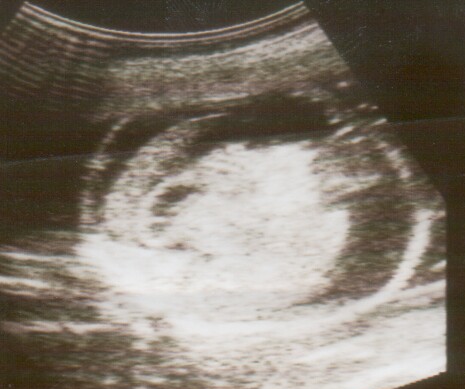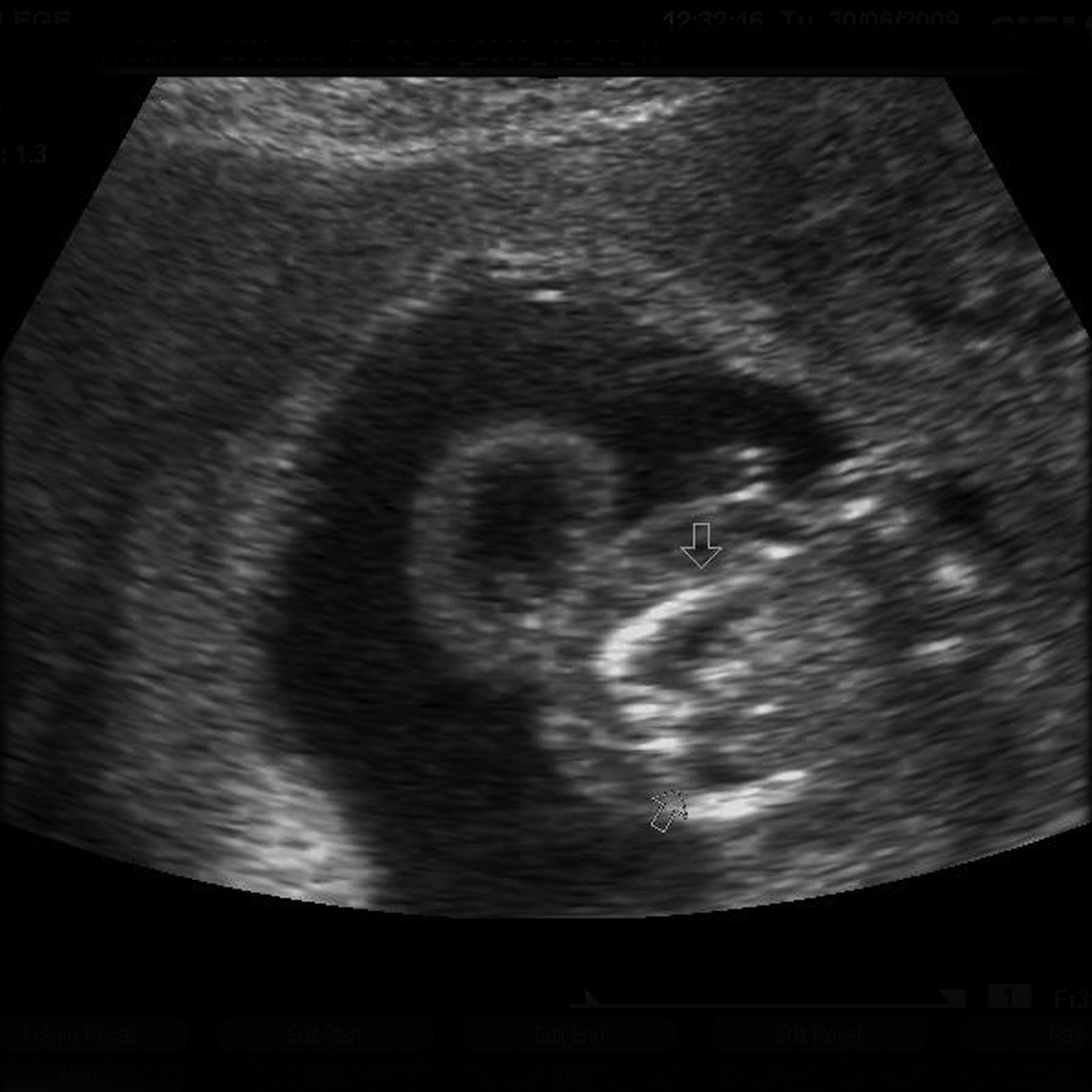Sandbox:Ezici: Difference between revisions
Adnan Ezici (talk | contribs) No edit summary |
Adnan Ezici (talk | contribs) No edit summary |
||
| Line 66: | Line 66: | ||
==Differential Diagnosis== | ==Differential Diagnosis== | ||
*Hydrops Fetalis must be differentiated from other diseases that cause generalized skin [[edema]], [[ascites]], [[pleura]]l, or [[pericardial effusion]], [[placenta]]l enlargement, such as Mirror (Ballantyne) syndrome. | *Hydrops Fetalis must be differentiated from other diseases that cause generalized skin [[edema]], [[ascites]], [[pleura]]l, or [[pericardial effusion]], [[placenta]]l enlargement, such as Mirror (Ballantyne) syndrome. | ||
*However, Mirror (Ballantyne) syndrome is also characterized by maternal edema (the mother mirrors the edema present in the fetus), proteinuria, and hypertension.<ref name="pmid30614331">{{cite journal| author=Hobson SR, Wallace EM, Chan YF, Edwards AG, Teoh MWT, Khaw AP| title=Mirroring preeclampsia: the molecular basis of Ballantyne syndrome. | journal=J Matern Fetal Neonatal Med | year= 2020 | volume= 33 | issue= 5 | pages= 768-773 | pmid=30614331 | doi=10.1080/14767058.2018.1500550 | pmc= | url=https://www.ncbi.nlm.nih.gov/entrez/eutils/elink.fcgi?dbfrom=pubmed&tool=sumsearch.org/cite&retmode=ref&cmd=prlinks&id=30614331 }} </ref> | *However, Mirror (Ballantyne) syndrome is also characterized by maternal [[edema]] (the mother mirrors the [[edema]] present in the [[fetus]]), [[proteinuria]], and [[hypertension]].<ref name="pmid30614331">{{cite journal| author=Hobson SR, Wallace EM, Chan YF, Edwards AG, Teoh MWT, Khaw AP| title=Mirroring preeclampsia: the molecular basis of Ballantyne syndrome. | journal=J Matern Fetal Neonatal Med | year= 2020 | volume= 33 | issue= 5 | pages= 768-773 | pmid=30614331 | doi=10.1080/14767058.2018.1500550 | pmc= | url=https://www.ncbi.nlm.nih.gov/entrez/eutils/elink.fcgi?dbfrom=pubmed&tool=sumsearch.org/cite&retmode=ref&cmd=prlinks&id=30614331 }} </ref> | ||
==Epidemiology and Demographics== | ==Epidemiology and Demographics== | ||
Revision as of 21:26, 30 April 2021
Hydrops Fetalis
Overview
Hydrops Fetalis indicates an excessive accumulation of interstitial fluid in extravascular compartments and body cavities which is characterized by generalized skin edema, ascites, pleural, or pericardial effusion, placental enlargement. It may be classified into two groups based on the presence or absence of rhesus iso-immunization. Although Rh disease is the major cause of immune-mediated hydrops fetalis, with the decreased prevalence of Rh disease, non-immune causes (eg, cardiovascular diseases, chromosomal abnormalities, lymphatic anomalies, hematologic diseases, etc.) are responsible in the majority of cases. Screening for Rh(D) incompatibility by Rh(D) blood typing and antibody testing are strongly recommended for all pregnant women during their first visit for pregnancy-related care. Also repeated Rh(D) antibody testing for all unsensitized Rh(D)-negative women at 24 to 28 weeks gestation is recommended, unless the biological father is known to be Rh(D) negative. Prognosis is generally poor, and the mortality rate of patients with non-immune hydrops fetalis (NIHF) is approximately 43.2% at 1 year of age, and the presence of either large birth weight, polyhydramnious, or prematurity are associated with a particularly poor prognosis among patients. to be continued...
Historical Perspective
Hydrops fetalis was first discovered by Dr. John William Ballantyne, a Scottish physician and obstetrician, in 1892.
Classification
Hydrops Fetalis may be classified into two groups based on the presence or absence of rhesus iso-immunization:
- Immune Hydrops Fetalis
- Non-Immune Hydrops Fetalis (NIHF)
Pathophysiology
It is thought that hydrops fetalis is caused by conditions with either increased rate of fluid transudation from the vascular compartment or decreased lymphatic return to the circulation.
- This is shown to be originated from developmental defects in microcirculation and lymphatic system, respectively.[1]
- The potential causes may be immune or non-immune, and they often result in anemia and further hypoxia.
- The sympathetic system becomes activated due to hypoxia, and it causes blood redistribution with decreased blood flow to the liver and kidneys.
- Decreased blood flow to the liver and kidneys, results in decreased albumin, increased ADH, and increased activity of RAAS.
- Following these changes, the central venous pressure increases, which further results in decreased lymphatic return.
- As a result, hydrops fetalis (the accumulation of fluid, or edema, in at least two fetal compartments)[2] occurs.
- The pathophysiology of non-immune causes also depend on the underlying conditions, include:
- Decreased ventricular filling during diastole (i.e. tachyarrhythmias)
- Increased central venous pressure due to the increased right heart pressure (i.e. cardiac tumors and subendocardial fibroelastosis)
- Obstruction of lymphatic drainage due to a mass (i.e. cystic hygroma)
Causes
Hydrops Fetalis is caused by either immune or non-immune conditions.
- Immune hydrops fetalis
- Antibodies may occur due to the exposure to non-self RBC antigens during the previous pregnancy or transfusion.
- In the next pregnancy, these antibodies may attack the fetal erythrocytes if the fetus has that antigen.
- Following the red blood cell destruction, hemolytic disease of the fetus and newborn (HDFN) may occur with a wide range of clinical outcome from only mild anemia to high output heart failure and hydrops fetalis.[3]
- Rh disease is the major cause of immune-mediated hydrops fetalis; however, owing to preventative methods developed in the 1970s, the incidence of Rh disease has markedly declined.
- Rh disease can be prevented by the administration of anti-D IgG (Rho (D) Immune Globulin) injections to RhD-negative mothers during pregnancy and/or within 72 hours of the delivery.
- Non-immune hydrops fetalis (NIHF)
- Currently, with the decreased prevalence of Rh disease, non-immune causes are responsible in the majority of cases.
- The most common causes of non-immune hydrops fetalis are cardiovascular diseases, chromosomal abnormalities, lymphatic anomalies, and hematologic diseases. Causes of NIHF include:[4][5]
- Structural cardiac malformations (especially hypoplastic left heart, endocardial cushion defect)
- Arrhythmias
- Congenital lymphatic dysplasia
- Chromosomal abnormalities (Turner Syndrome, trisomy 13, trisomy 18, trisomy 21)
- Alpha-thalassemia
- Fetomaternal transfusion
- Infections (Parvovirus-B19, CMV, Adenovirus, Enterovirus)
- Twin to twin transfusion syndrome (both donor and recipient fetus)
- Congenital cystic adenomatoid malformation
- Diaphragmatic hernia
- Extrapulmonary sequestration
- Hydrothorax
- Chylothorax
- Noonan Syndrome
- Urethral Obstruction
- Prune belly syndrome
- Lysosomal storage diseases
- Vascular tumors
- Teratoma
- Leukemia
- Hepatic tumors
- Neuroblastoma
- Meconium peritonitis
- Gastrointestinal obstructions
- Approximately 20% of the NIHF cases are idiopathic.
Differential Diagnosis
- Hydrops Fetalis must be differentiated from other diseases that cause generalized skin edema, ascites, pleural, or pericardial effusion, placental enlargement, such as Mirror (Ballantyne) syndrome.
- However, Mirror (Ballantyne) syndrome is also characterized by maternal edema (the mother mirrors the edema present in the fetus), proteinuria, and hypertension.[6]
Epidemiology and Demographics
- In developed countries, the incidence of non-immune hydrops fetalis (NIHF) is 25-79 per 100.000 live born infants worldwide.[7][8]
- The median gestational age (GA) at diagnosis of NIHF is 23 weeks.
Risk Factors
Maternal risk factors in the development of non-immune hydrops fetalis (NIHF) include:[8]
- Multiple gestation
- Preexisting maternal diabetes
- Mental illness
- Illicit drug use
- Preeclampsia
Screening
- According to the U.S. Preventive Services Task Force (USPSTF), screening for Rh(D) incompatibility by Rh(D) blood typing and antibody testing are strongly recommended for all pregnant women during their first visit for pregnancy-related care.
- The USPSTF recommends repeated Rh(D) antibody testing for all unsensitized Rh(D)-negative women at 24 to 28 weeks gestation, unless the biological father is known to be Rh(D) negative.[9]
Natural History, Complications, and Prognosis
Prognosis is generally poor, and the mortality rate of patients with non-immune hydrops fetalis (NIHF) is approximately 43.2% at 1 year of age.[8]
- Deaths usually occur in the neonatal period.
- The cause of deaths after the neonatal period are usually underlying disease rather than hydrops fetalis itself.
- Gestational age is predictive of mortality, as preterm infants with this condition are more likely to die.
- The presence of either large birth weight, polyhydramnious, or prematurity are associated with a particularly poor prognosis among patients.
Diagnosis
Diagnostic Study of Choice
History and Symptoms
Physical Examination
Laboratory Findings
- Hydrops Fetalis may be caused by maternal TORCH infections, and parvovirus B19 infection, therefore, antibodies against these infections should be checked.[1]
- Sjögren syndrome may cause hydrops fetalis with complete heart blocks and bradyarrhythmias, therefore, Anti-SS-A/SS-B antibodies should be considered in suspected cases.
- An elevated concentration of alpha-fetoprotein (AFP) may suggest fetomaternal hemorrhage, which may result in hydrops fetalis.
- Immune hydrops fetalis can be detected by direct and indirect coombs test.
- Thyroid hormone levels, complete blood count, and metabolic panel also should be checked in the neonatal period.
Electrocardiogram
X-ray
Ultrasound


CT Scan
MRI
Other Imaging Findings
Other Diagnostic Studies
- Other diagnostic studies for hydrops fetalis include chorionic villous sampling (CVS), which may demonstrate chromosomal abnormalities or Hb Barts disease.[1]
Treatment
Medical Therapy
Surgery
Primary Prevention
Secondary Prevention
References
- ↑ 1.0 1.1 1.2 Vanaparthy R, Mahdy H. PMID 33085361 Check
|pmid=value (help). Missing or empty|title=(help) - ↑ Kontomanolis EN, Fasoulakis Z (2018). "Hydrops Fetalis and THE Parvovirus B-19". Curr Pediatr Rev. 14 (4): 239–252. doi:10.2174/1573396314666180820154340. PMID 30124157.
- ↑ Moise KJ (July 2005). "Red blood cell alloimmunization in pregnancy". Semin Hematol. 42 (3): 169–78. doi:10.1053/j.seminhematol.2005.04.007. PMID 16041667.
- ↑ Bellini C, Donarini G, Paladini D, Calevo MG, Bellini T, Ramenghi LA, Hennekam RC (May 2015). "Etiology of non-immune hydrops fetalis: An update". Am J Med Genet A. 167A (5): 1082–8. doi:10.1002/ajmg.a.36988. PMID 25712632.
- ↑ Bellini C, Hennekam RC (March 2012). "Non-immune hydrops fetalis: a short review of etiology and pathophysiology". Am J Med Genet A. 158A (3): 597–605. doi:10.1002/ajmg.a.34438. PMID 22302731.
- ↑ Hobson SR, Wallace EM, Chan YF, Edwards AG, Teoh MWT, Khaw AP (2020). "Mirroring preeclampsia: the molecular basis of Ballantyne syndrome". J Matern Fetal Neonatal Med. 33 (5): 768–773. doi:10.1080/14767058.2018.1500550. PMID 30614331.
- ↑ Meng, Dahua; Li, Qifei; Hu, Xuehua; Wang, Lifang; Tan, Shuyin; Su, Jiasun; Zhang, Yue; Sun, Weijia; Chen, Biyan; He, Sheng; Lin, Fei; Xie, Bobo; Chen, Shaoke; Agrawal, Pankaj B.; Luo, Shiyu; Fu, Chunyun (2019). "Etiology and Outcome of non-immune Hydrops Fetalis in Southern China: report of 1004 cases". Scientific Reports. 9 (1). doi:10.1038/s41598-019-47050-6. ISSN 2045-2322.
- ↑ 8.0 8.1 8.2 Steurer MA, Peyvandi S, Baer RJ, MacKenzie T, Li BC, Norton ME, Jelliffe-Pawlowski LL, Moon-Grady AJ (August 2017). "Epidemiology of Live Born Infants with Nonimmune Hydrops Fetalis-Insights from a Population-Based Dataset". J Pediatr. 187: 182–188.e3. doi:10.1016/j.jpeds.2017.04.025. PMID 28533037.
- ↑ "Screening for Rh(D) Incompatibility: Recommended Statement - U.S. Preventive Services Task Force - American Family Physician".